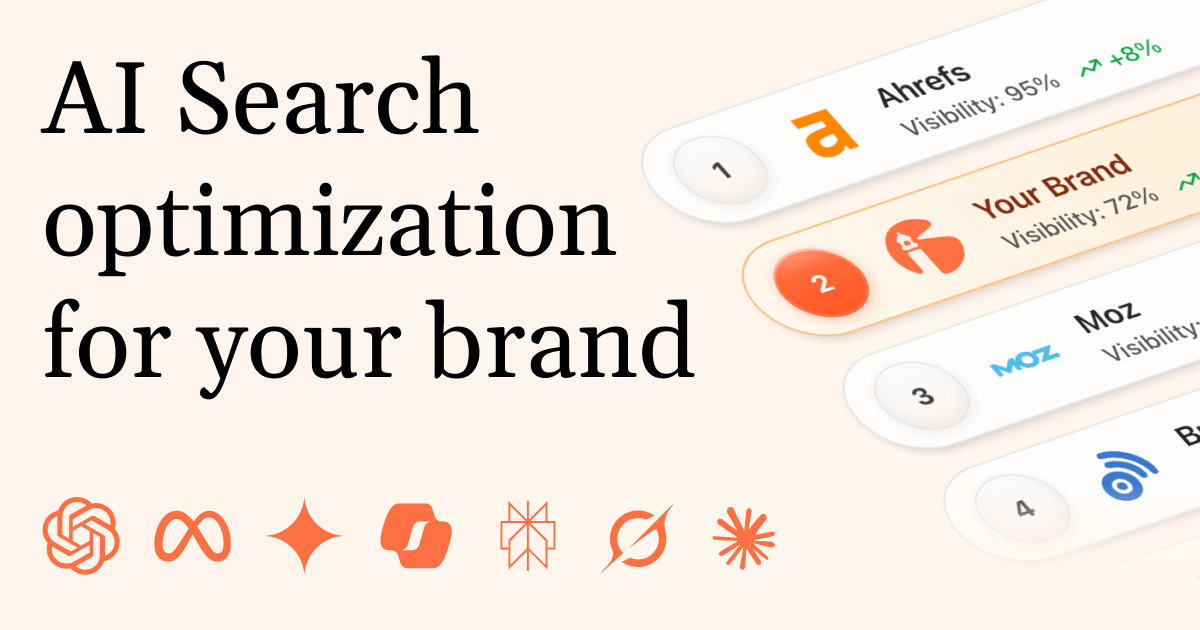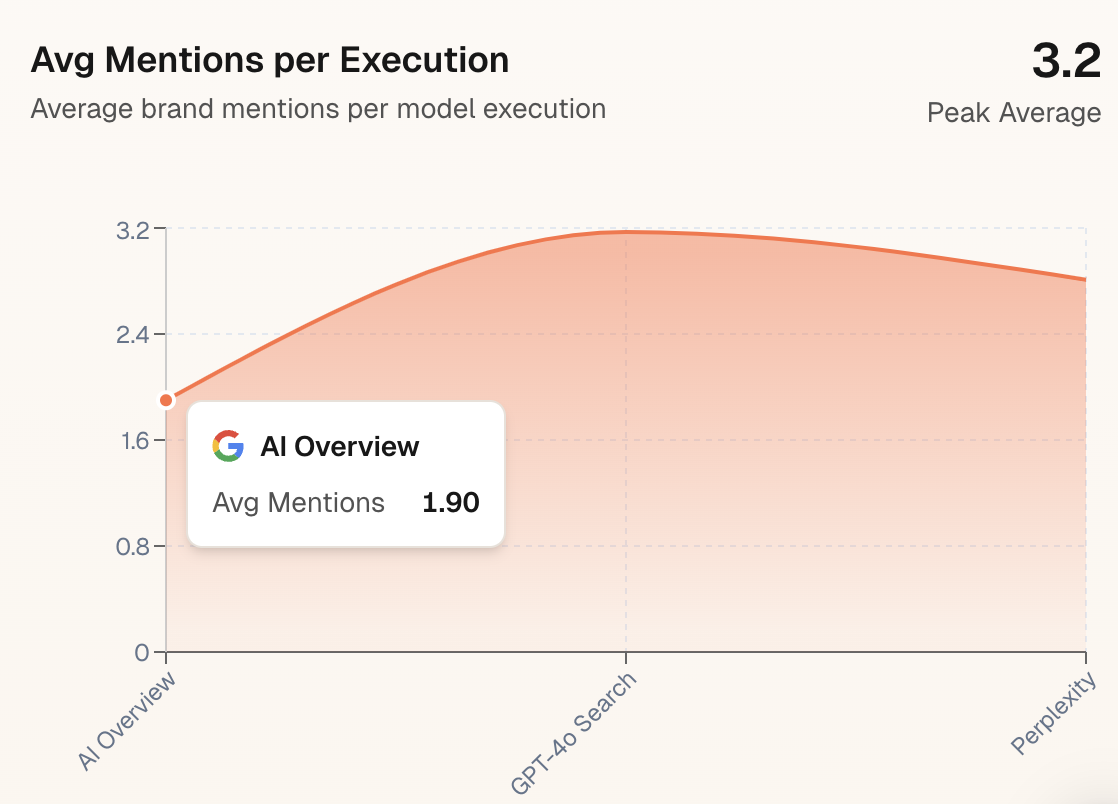The AI search landscape is evolving rapidly, and with over $31 million flowing into AI search visibility tracking tools in just the last two years, the market has become incredibly crowded. New platforms are launching constantly, making it challenging to identify which tools actually deliver value for your investment.
If you're wondering which AI search visibility tracking tools are worth your time and budget in 2025, you're not alone. This comprehensive guide analyzes the top 21 platforms currently available, helping you make an informed decision based on real-world performance and value.
What Is AI Search Visibility Tracking?
AI search visibility tracking monitors how your brand, products, or content appear in responses from AI-powered search engines and chatbots. Unlike traditional SEO rank tracking that focuses on search engine results pages (SERPs), AI visibility tracking examines:
- AI Chatbots: ChatGPT, Claude, Gemini responses
- Meta Answers: Google AI Overviews and AI Mode
- Vertical AI Engines: Perplexity, specialized AI search tools
- AI Copilots: Microsoft Copilot and similar assistants
The challenge lies in the dynamic nature of AI responses – the same query can produce different results across multiple runs, making consistent tracking complex but essential for modern digital marketing strategies.
Top 3 AI Search Tracking Tools (Best Value)
Based on comprehensive price-to-value analysis, three tools stand out as the best options for most businesses:
1. Vaylis - Starting at $49/month, 50 daily tracked prompts
Best for comprehensive AI search visibility monitoring
Vaylis provides comprehensive brand monitoring across all major AI search platforms including ChatGPT, Perplexity, Google AI Overviews, and more. The platform offers real-time tracking, competitor analysis, and actionable optimization recommendations to help brands maintain visibility in the evolving AI search landscape.
Key Features:
- Real-time brand monitoring across 8+ AI platforms
- Competitor visibility benchmarking
- AI search optimization recommendations
- Advanced analytics dashboard
Pros:
- Comprehensive coverage of major AI platforms
- User-friendly interface and quick setup
- Competitive pricing for the feature set
- Focus on actionable insights
Cons:
- Newer platform with evolving feature set
- Limited historical data compared to established tools
- Best suited for brand monitoring vs deep technical SEO
2. Peec AI - $99/month, 25 daily tracked prompts
Best specialist platform for multi-engine monitoring
Peec AI was built specifically for AI search visibility rather than being retrofitted from traditional SEO tools. This focused approach shows in their comprehensive monitoring capabilities across multiple AI platforms.
Key Features:
- Multi-platform monitoring (ChatGPT, Perplexity, Google AI Overviews)
- Share-of-voice and sentiment analysis
- Branded vs non-branded prompt testing
- Agency-friendly data export options
Pros:
- Purpose-built for AI search tracking
- Fast onboarding process
- Comprehensive platform coverage
- Structured reporting capabilities
Cons:
- Pricing in euros may complicate budgeting
- Costs scale with prompt volume
- Limited surrounding content optimization features
3. LLMrefs - $79/month
Best entry-level option for SMBs and startups
LLMrefs positions itself as an accessible entry point into AI visibility tracking, offering essential features at a budget-friendly price point. Their proprietary LLMrefs Score helps identify quick-win optimization opportunities.
Key Features:
- Live keyword crawling for AI engines
- Weekly trend reporting
- Competitor benchmarking
- GEO hygiene guidance (Bing indexing, llms.txt optimization)
Pros:
- Most affordable comprehensive option
- Freemium tier available
- Actionable optimization recommendations
- Good for testing AI visibility strategies
Cons:
- Smaller dataset compared to enterprise platforms
- Weekly sampling may miss rapid changes
- Limited advanced analytics features
Complete Rankings: All 20 AI Search Tracking Tools
Here's the complete ranking of AI search visibility tracking tools, organized by overall value and market position:
| Rank | Tool | Pricing | Funding Status | Best For |
|---|---|---|---|---|
| 1 | Vaylis AI | $49/mo | Bootstrapped | Full platform to get clients |
| 2 | Peec AI | $99/mo | $1.9M funding | Specialized AI search monitoring |
| 3 | LLMrefs | $79/mo | Bootstrapped | SMBs and startups |
| 4 | Scrunch AI | $300/mo | $19M funding | Enterprise AI optimization |
| 5 | Profound | $499/mo | $23.5M funding | Enterprise analytics |
| 6 | AthenaHQ | $295/mo | $2.3M funding | Mid-market agencies |
| 7 | Rankscale AI | $20/mo | Bootstrapped | Budget-conscious users |
| 8 | Otterly AI | $29/mo | Bootstrapped | Small businesses |
| 9 | Writesonic GEO | $99/mo | Bootstrapped | Content creators |
| 10 | SE Ranking's AI Visibility Tracker | $79/mo | Bootstrapped | Existing SE Ranking users |
| 11 | Surfer AI Tracker | $194/mo | Bootstrapped | Content optimization focus |
| 12 | Nightwatch LLM Tracking | $32/mo | Bootstrapped | Basic monitoring needs |
| 13 | Keyword.com AI Tracker | $25/mo | Bootstrapped | Keyword research integration |
| 14 | Geneo AI | $39/mo | Bootstrapped | Simple tracking requirements |
| 15 | Knowatoa AI | $99/mo | Bootstrapped | Balanced feature set |
| 16 | ZipTie | $99/mo | Bootstrapped | Developer-friendly tools |
| 17 | Am I On AI | $100/mo | Bootstrapped | Brand mention tracking |
| 18 | Hall AI | $239/mo | Bootstrapped | Advanced analytics |
| 19 | Ahrefs' Brand Radar | $699/mo | Bootstrapped | Comprehensive SEO integration |
| 20 | Semrush's AI Toolkit | $745/mo | Public Company | Enterprise SEO platforms |
| 21 | seoClarity ArcAI | $3,000/mo | Bootstrapped | Enterprise-only solutions |
Key Selection Criteria for AI Search Tracking Tools
When evaluating AI search visibility tracking platforms, consider these critical factors:
1. Platform Coverage Breadth
The most valuable tools monitor multiple AI engines simultaneously. Look for coverage of:
- ChatGPT and GPT-powered applications
- Google AI Overviews and Gemini
- Perplexity and vertical AI search engines
- Claude and other major language models
- Emerging AI platforms in your industry
2. Data Collection Methodology
Transparency in data collection is crucial for reliable insights:
- Sampling Frequency: How often are prompts tested?
- Repetition Strategy: Multiple runs per prompt for consistency
- Citation Capture: Ability to track source attribution
- API vs UI Testing: Method of data collection affects reliability
3. Actionability Beyond Monitoring
The best tools help you improve visibility, not just track it:
- Gap analysis and optimization recommendations
- Content optimization integration
- Competitor benchmarking insights
- Technical implementation guidance
4. Scalability and Collaboration
Consider your team's needs:
- Multi-user access and permission controls
- Agency-client reporting capabilities
- Data export and integration options
- Prompt volume scaling options
5. Market Validation
In a rapidly evolving space, look for signs of platform durability:
- Funding status and financial backing
- Market adoption evidence
- Regular feature updates and improvements
- Responsive customer support
Industry Insights: The $31 Million AI Search Market
The AI search visibility tracking market has attracted significant investment, with over $31 million in funding flowing to various platforms. This rapid growth indicates both the importance of AI search visibility and the competitive nature of the space.
Market Trends:
- Consolidation Expected: Many bootstrapped tools may struggle against well-funded competitors
- Feature Convergence: Similar capabilities emerging across platforms
- Pricing Pressure: Industry average of $337/month may decrease as competition intensifies
- Integration Focus: Tools connecting with existing SEO and content workflows gaining advantage
Getting Started with AI Search Tracking
Step 1: Define Your Monitoring Strategy
Before selecting a tool, clarify your objectives:
- Which AI platforms are most relevant to your audience?
- What types of queries should you monitor (branded, commercial, informational)?
- How frequently do you need data updates?
- What's your budget for AI search tracking?
Step 2: Start with Free Trials
Most platforms offer trial periods. Test 2-3 tools simultaneously with the same prompt sets to compare:
- Data accuracy and consistency
- User interface usability
- Reporting capabilities
- Customer support quality
Step 3: Implement Gradually
Begin with core monitoring before expanding:
- Start with branded queries and top competitors
- Establish baseline measurements
- Gradually add commercial and informational keywords
- Scale up platform coverage as you gain insights
Step 4: Connect to Optimization Workflows
The most successful AI search strategies combine monitoring with action:
- Link tracking data to content optimization processes
- Establish regular review cycles for AI visibility performance
- Create workflows for addressing visibility gaps
- Monitor the impact of optimization efforts
Common Pitfalls to Avoid
Over-Investing in Enterprise Features Too Early
Many businesses jump to expensive enterprise platforms before understanding their actual needs. Start with mid-tier options and scale up based on proven value.
Ignoring Data Quality Variations
AI responses are inherently variable. Ensure your chosen tool uses sufficient sampling to provide reliable insights rather than single-query snapshots.
Focusing Only on Mentions
Tracking mentions without understanding context, sentiment, and competitive positioning provides limited value. Choose tools that offer deeper analysis capabilities.
Neglecting Technical Optimization
Many marketers focus on content optimization while ignoring technical factors that improve AI citation chances, such as proper structured data and AI-friendly site architecture.
Future Outlook: What's Next for AI Search Tracking
The AI search tracking landscape will likely see significant changes in the coming year:
Expected Developments:
- Real-time Monitoring: Faster data refresh cycles across platforms
- Advanced Analytics: Better prediction and trend analysis capabilities
- Integrated Optimization: Deeper connections between tracking and content creation tools
- Cross-Platform Attribution: Understanding how AI visibility impacts overall marketing performance
Emerging Challenges:
- Platform Fragmentation: New AI engines requiring additional monitoring
- Privacy Considerations: Potential restrictions on AI response tracking
- Cost Management: Balancing comprehensive coverage with budget constraints
- Skill Development: Training teams to interpret and act on AI visibility data
Conclusion: Making the Right Choice
The AI search visibility tracking market offers solutions for every budget and need level. For most businesses, starting with one of the top three value leaders – Rankability's AI Analyzer, Peec AI, or LLMrefs – provides the best combination of features, reliability, and cost-effectiveness.
Remember that AI search tracking is most valuable when integrated with broader content and SEO strategies. Choose a tool that not only monitors your visibility but also helps you improve it through actionable insights and optimization recommendations.
As the AI search landscape continues evolving, the platforms that survive and thrive will be those that provide not just data, but genuine competitive advantage through superior insights and integration capabilities. Start with a tool that meets your current needs while offering room to grow as your AI search strategy matures.
The investment in AI search visibility tracking isn't just about monitoring – it's about positioning your brand for success in the AI-powered search future that's already here.


